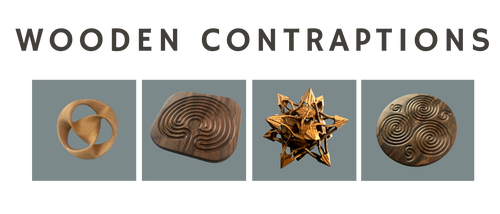Labyrinth is Not a Maze

Both a labyrinth and a maze are formed by twisted and turning paths. A maze consists of branching paths, with dead ends and a possibility of being lost. A labyrinth, on the other hand, has a single, defined path. No matter how complicated the pattern, if you follow the path, you will reach the center of the labyrinth, and you will be able to exit it the same way. A labyrinth may be complex, but it is not difficult to navigate.
A motif of a labyrinth has been present in many cultures. Some motifs have spiritual significance and can be used as tools for personal and spiritual transformation. Labyrinths are used in meditation, or simply as tools for mindfulness and relaxation.
The pattern shown above is a 7-circuit Cretan labyrinth. The depictions of this labyrinth have been found in many cultures, including on ancient Cretan coins. Variations of this labyrinth have been found in Iceland, Scandinavia, Crete, Egypt, Peru, Arizona, India, and Sumatra.
LABYRINTH FROM CHARTRES CATHEDRAL

This labyrinth, which has been set in the floor of the Chartres cathedral in France, is probably the most famous walking labyrinth. As far as we know, similar labyrinths were included in 23 different cathedrals built in medieval ages (out of around 80). Only a few remain nowadays, out of which the Chartres Cathedral labyrinth is the best preserved one.
Walking the labyrinth is a right-brain activity enhancer and helps calm oneself and enhances problem-solving. Finger labyrinths offer a way to experience the labyrinth at home. A carved finger path makes it unnecessary to look, allowing one to focus on the walk. By moving a finger slowly along the path, the "walker" can calm and center oneself. The principle is very simple, yet powerful.
The full Chartres labyrinth is based on 11 concentric circles. We found that a smaller, 7-circuit version of the labyrinth, is more versatile for a handheld labyrinth. It balances the size of the labyrinth with the needs of meditation at home. We offer both 7-cm and 11-circuit version of this labyrinth.
TRIPLE SPIRAL, TRISKELION OR TRISKELE

A triple spiral exhibiting rotational symmetry is called a triskelion or triskele. The name comes from the Greek word 'triskeles', meaning 'three legs'. This symbol had a major prominence in Celtic beliefs, where it was associated with the god Manannán mac Lir, but it has appeared in many early cultures across Europe and Asia.
The meaning of triskele is varied and open to diverse interpretations, making it a versatile tool for a variety of meditations. It can represent movement, flow, and cycles of life. It is also used to symbolize various triplicities in cosmology and theology: life-death-rebirth, past-present-future, spirit-mind-body, Sacred Feminine Goddess maiden-mother-crone.
This labyrinth is unique, as it is continuous - a single line goes in and out of each spiral. There is no exit or entry, a 'walker' can follow the endless path for as long as needed.
